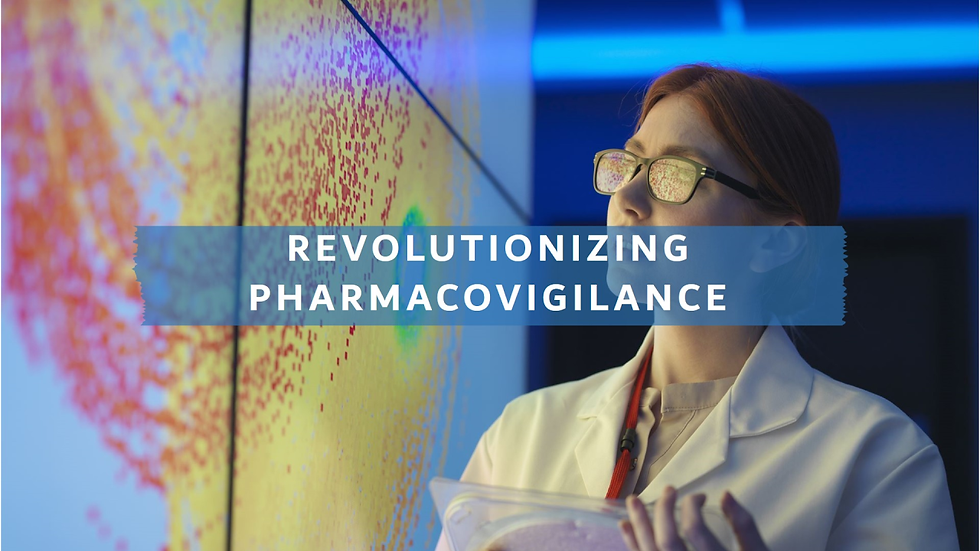
Pharmacovigilance, the science and activities related to the detection, assessment, understanding, and prevention of adverse effects or any other drug-related problems, stands at the forefront of ensuring medication safety. As the pharmaceutical landscape evolves, driven by advances in technology and a growing array of therapies, the role of pharmacovigilance becomes increasingly crucial. In this blog, we'll delve into the future of pharmacovigilance, particularly focusing on the transformative impact of Artificial Intelligence (AI) in case intake processes.
The Current Landscape of Pharmacovigilance: In recent years, pharmacovigilance has undergone significant transformation, moving from manual processes to more automated systems. Traditional methods relied heavily on manual reporting and analysis, making it time-consuming and prone to errors. However, with the advent of technology, including AI and machine learning, the pharmacovigilance landscape has witnessed a paradigm shift.
AI in Pharmacovigilance Case Intake: One of the areas where AI is making substantial inroads is in case intake—the process of collecting, reviewing, and analyzing adverse event reports. AI-powered algorithms are capable of automating various aspects of this process, leading to increased efficiency, accuracy, and scalability.
Automated Data Extraction: AI algorithms can sift through vast amounts of unstructured data from various sources, including medical literature, social media, and electronic health records, to identify potential adverse events associated with medications. Natural Language Processing (NLP) techniques enable machines to extract relevant information from text, enabling faster identification of safety signals.
Signal Detection and Prioritization: By analyzing large datasets, AI algorithms can identify patterns and correlations that might indicate previously unrecognized adverse reactions. These algorithms can prioritize signals based on factors such as severity, frequency, and potential impact on patient safety, allowing pharmacovigilance professionals to focus their attention where it's most needed.
Risk Assessment and Causality Analysis: Determining the causal relationship between a medication and an adverse event is a critical aspect of pharmacovigilance. AI-powered systems can analyze clinical data, patient profiles, and medical histories to assess the likelihood of a drug causing a particular adverse event. This automated approach not only speeds up the process but also enhances the accuracy of causality assessments.
Streamlined Case Triage: AI can assist in triaging incoming cases based on their urgency and severity. By automatically categorizing reports according to predefined criteria, AI algorithms ensure that critical issues receive immediate attention while less urgent matters are addressed in a timely manner. This helps pharmacovigilance teams prioritize their workload and allocate resources more effectively.
Benefits of AI in Pharmacovigilance Case Intake: The integration of AI into pharmacovigilance case intake processes offers numerous benefits:
Enhanced Efficiency: AI automation reduces the time and effort required for manual data entry, allowing pharmacovigilance professionals to focus on higher-value tasks such as signal evaluation and risk management.
Improved Accuracy: AI algorithms can analyze large volumes of data with greater precision than humans, reducing the risk of errors and ensuring more reliable safety assessments.
Faster Signal Detection: AI-enabled systems can detect safety signals in real-time, enabling proactive risk mitigation strategies and faster response to emerging safety concerns.
Scalability: AI-powered platforms can handle large volumes of data efficiently, making them well-suited for pharmacovigilance activities in an era of increasingly complex healthcare systems and expanding drug pipelines.
Challenges and Considerations: While AI holds immense promise for revolutionizing pharmacovigilance, several challenges and considerations must be addressed:
Data Quality and Standardization: AI algorithms rely on high-quality data for accurate analysis. Ensuring data integrity, completeness, and standardization across different sources remains a challenge in pharmacovigilance.
Regulatory Compliance: Regulatory agencies have stringent requirements for pharmacovigilance data collection and reporting. AI systems must comply with regulatory standards to ensure the validity and reliability of safety assessments.
Interpretability and Transparency: The black-box nature of some AI algorithms raises concerns about the interpretability and transparency of decision-making processes. Pharmacovigilance professionals must be able to understand and explain the rationale behind AI-generated insights.
Human Oversight and Intervention: While AI can automate many aspects of pharmacovigilance case intake, human expertise remains indispensable for complex decision-making, particularly in ambiguous or novel situations. Human oversight ensures that AI-generated insights are properly interpreted and acted upon.
The Future of Pharmacovigilance: Looking ahead, the future of pharmacovigilance is intertwined with the continued advancement and integration of AI technologies. Key trends shaping the future landscape include:
Predictive Analytics: AI algorithms will increasingly be used to predict adverse events before they occur, enabling proactive risk management and personalized patient care.
Real-time Monitoring: Continuous monitoring of drug safety using AI-powered surveillance systems will become standard practice, allowing for rapid detection and response to emerging safety signals.
Personalized Medicine: AI-driven pharmacovigilance will support the development of personalized medicine approaches, tailoring treatments to individual patient characteristics and minimizing the risk of adverse reactions.
Collaborative Networks: Pharmacovigilance will become more collaborative, with stakeholders across the healthcare ecosystem sharing data and insights to enhance patient safety on a global scale.
Conclusion: The future of pharmacovigilance holds tremendous promise, driven by the transformative potential of AI technologies. By automating and augmenting case intake processes, AI enables pharmacovigilance professionals to more effectively monitor, assess, and mitigate drug-related risks. While challenges remain, the integration of AI into pharmacovigilance represents a significant step forward in ensuring medication safety and improving patient outcomes in the evolving healthcare landscape.
Learn more about SALVUS and discover how your organization can transition to a Drug Safety Database which supports AI Intake. Ready to see it in action? Request a demo today.

Comments